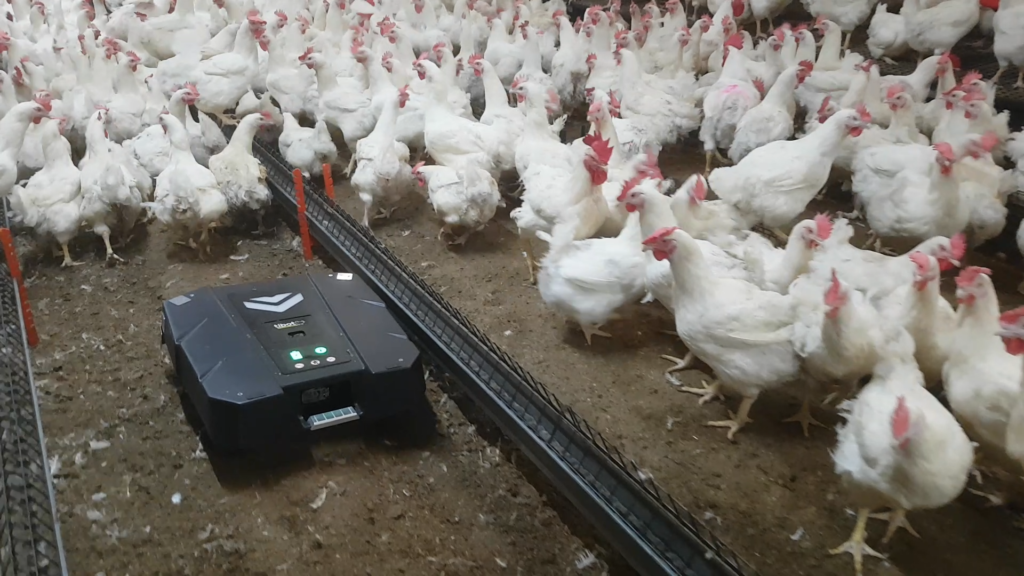
SAVE THE DATE – IPPE 2023 – Atlanta
We invite you to the IPPE tradeshow from January 24…


Turkey breeders

Broiler breeders

Layers
Good mating is a major concern for poultry farmers, and rightly so! A drop in coitus results in insufficient fertility results, meaning a loss of income for the farmer and profitability for the hatchery. However, stimulating mating is not easy: Genetics play a major role, but as flocks and rearing conditions vary, some trial and error is usually necessary. Are you looking for new options? Read on and learn what the poultry robot can do.
According to the scientific literature on coitus, there are various possible causes for insufficient fertility. Though best practices are helpful, they do not fully solve the problem of mating in livestock settings.
As you know, it’s generally advisable to look at the following factors to promote mating.
As soon as the males are ready, they try to mate, which frightens off the females who have not reached sexual maturity. Conversely, the roosters are the ones vulnerable to harassment if they are too young. Bottom line: It’s best to mingle males and females that reach sexual maturity at the same time or, if you have older roosters, add them gradually after 14 to 21 weeks.
This ratio depends on the breed, and it’s important to follow the breeder’s recommendations. In any case, there’s no point in trying to increase the number of mating attempts with a higher ratio of males than recommended. Biologically, roosters mate ten times more than they need to around 25 weeks. If there are too many of them, the females may be overburdened and develop an aversion to the males. In the end, this approach is therefore counterproductive, since it leads to an increase in the rejection rate.
Not surprisingly, breeding conditions influence fertility. It has been found that a density of five birds per square meter gives better mating results than a density of about eight birds per square meter. Light is also recognized as important. With these best practices fresh in mind, it should nonetheless be noted that even with them in place, many breeders are still faced with behaviors that inhibit mating.
What difficulties tend to arise in breeding? Though situations vary, it must be noted that several phenomena may hinder mating.
First of all, no matter the conditions under which they’re kept, the animals are unable to behave as they would in the wild. Courtship, which enhances mating, is limited due to lack of space. This prevents certain signals (dancing, singing, flapping, etc.) to which the females are sensitive.
Secondly, it’s not always easy to detect aggressive roosters, and their behavior can negatively impact that of the females. When harassed, and in some cases injured, they refuse to mate.
Finally, and we realize this is common sense, don’t forget that for mating to occur, males and females must meet! But how to get them to meet is never obvious, as the females naturally circulate throughout the building, whereas the roosters have a limited range.
Today, there are already simple tricks to mitigate the problems listed above. For aggressive roosters, one easy solution is to position their feeding system in such a way as to divert their attention away from the females, leaving them more options to escape if necessary. Adding new roosters has also proved its worth, by effectively maintaining fertility at the highest level, provided that the animals are well-chosen.
Although appealing, these two techniques also have disadvantages, namely the need to adapt the farm conditions, or, if adding new roosters, the risk of introducing disease.
For this reason, mingling the animals using a robot is a complementary approach that deserves to be explored. This quickly profitable solution (just invest in a poultry robot, which pays for itself over one flock) brings concrete results, without requiring any installation or involving any risk.
By moving randomly around the building, the poultry robot leads the animals to mingle and stimulates their natural behavior. A clear improvement in the roosters’ libido is observed, while the females act more receptive to mating.
In 2020, the Applied Innovation team at Hubbard, a world leader in broiler breeding, launched an experiment into the impact of a poultry robot on mating. The study involved two flocks of broiler breeders aged 48 and 55 weeks respectively.
Mating attempts increased by 30%, due to better mingling and more sustained activity by the birds, as Mathieu Lardière, technical manager for Middle East Africa and head of Hubbard’s Applied Innovation team explains:
“The presence of the robot in the building allows the hens and roosters to maintain a good level of activity, which generates a larger number of mating attempts, particularly in the two hours before the lights go out. This is especially interesting since the literature shows that the hen needs to be mated more often after 45 weeks of age.”
In addition, there is less of the deviant behavior that makes mating difficult, such as herding.
“Some farmers have told us that without a robot, the roosters would herd the hens, which would gather together at the back of the building. For them, the robot helped by recreating the mingled environment. When you put it on, the chickens scatter, which cancels out the effect of herding.” Pierre, Tibot project manager
What is the connection between using a robot and the fertility of flocks? The above-mentioned experiment also addressed this issue, since after each observation phase, 120 eggs were incubated to assess the percentage of unfertilized eggs.
Here too, the results were convincing. The Hubbard team found that fertility stabilized in the 48-week-old flock and that the 55-week-old flock showed a 5-point increase in the number of fertilized eggs .
“During the various tests, more than 4,000 mating attempts were recorded. A strong correlation was found between the number of mating attempts and the fertility of a flock. The Spoutnic robot has helped us keep our animals active during the last hours of the day, a time when human presence can be limited,” says Mathieu Lardière.
The verdict is in: The poultry robot stimulates mating, which helps to improve the profitability of the farm. Would you like to know more about its effects on animals? See our article on how the poultry robot improves poultry behavior.